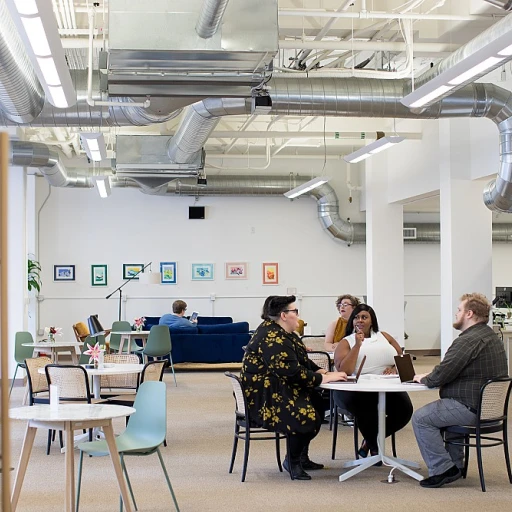
Defining leadership team development
What makes a leadership team effective during change?
Leadership team development is the process of building and strengthening the collective skills, relationships, and capabilities of a group of leaders within an organisation. This goes beyond individual leadership development. It focuses on how executive team members work together, make decisions, solve problems, and support each other to achieve business goals. A strong leadership team is essential for guiding people through complex change, ensuring that the organisation adapts and thrives.
In the context of change management, leadership team development helps teams align on vision, strategy, and priorities. It also encourages open communication and trust among team members, which is crucial when navigating uncertainty. Team building activities, conflict resolution training, and cross functional collaboration are all part of this development process. These efforts help team leaders and members feel more connected and confident in their roles.
Effective leadership teams are not just a collection of talented individuals. They are groups that have learned how to leverage each member’s strengths, address weaknesses, and work towards shared goals. This stage of development often involves structured learning, executive coaching, and ongoing training to enhance leadership skills such as decision making and problem solving. For a deeper look at the roles involved in successful change, you can explore the essential roles in change management.
Ultimately, developing leadership teams is about creating a culture where leaders support each other, adapt quickly, and drive the organisation forward. This foundation will help organisations manage change more effectively, setting the stage for the next steps in the change journey.
Why leadership team development matters in change management
Driving Successful Change Through Strong Leadership Teams
When an organisation faces change, the executive team and its leaders play a critical role in guiding people through uncertainty. Leadership team development is not just about individual growth; it is about building a cohesive group that can set clear goals, communicate a shared vision, and foster trust among team members. This collective strength helps the business adapt and thrive, even in challenging times.
Effective team development ensures that leadership teams are equipped to handle the complexities of change. When team members feel supported and empowered, they are more likely to contribute innovative ideas, engage in problem solving, and make sound decisions. This collaborative environment is essential for aligning the organisation’s strategy with its people, processes, and culture.
- Alignment: Development of the leadership team helps ensure that all members understand the organisation’s goals and the stage of change, so everyone moves in the same direction.
- Resilience: Teams with strong leadership skills can better manage conflict resolution and adapt to setbacks, keeping the change initiative on track.
- Cross-functional collaboration: Change often requires input from different departments. Leadership development encourages cross functional teamwork, breaking down silos and improving communication.
- Learning culture: Ongoing training and team building activities help leaders and team members continuously improve, which is vital for long-term success.
Leadership team development also supports the organisation by creating a pipeline of future leaders. As team leaders and members grow, they become more confident in their decision making and more effective at leading others through change. Investing in development leadership is not just about the present; it is about preparing the business for what comes next.
For a deeper look at how leadership teams can become true architects of change, explore how leaders of leaders empower transformation.
Key skills for leadership teams navigating change
Essential abilities for effective leadership teams
When an organisation faces change, the executive team and team leaders must rely on a specific set of skills to guide their teams through uncertainty. Strong leadership is not just about setting direction but also about equipping team members with the abilities needed to adapt and thrive. Here are some of the most important skills for leadership teams navigating change:
- Communication: Clear, transparent communication helps all team members understand what is happening, why changes are needed, and how they can contribute to business goals. This fosters trust and reduces resistance.
- Decision making: Effective leaders make timely, informed decisions, even with incomplete information. This skill ensures the organisation can move forward confidently during each stage of change.
- Problem solving: Change often brings unexpected challenges. Teams with strong problem-solving abilities can identify issues quickly and develop creative solutions that align with organisational objectives.
- Conflict resolution: As teams adapt, disagreements may arise. Leaders skilled in conflict resolution help members feel heard and valued, maintaining a positive environment for team development.
- Team building: Building trust and collaboration among team members is crucial. Leadership development programs that focus on team building can strengthen relationships and improve overall performance.
- Adaptability: The ability to adjust strategies and approaches as circumstances evolve is vital for both individual and team success during change initiatives.
- Cross functional collaboration: Many change projects require teams to work across departments. Leaders who encourage cross functional cooperation help break down silos and drive unified progress.
Leadership development and ongoing training are essential to help teams build these skills. Investing in diversity, equity, inclusion, and accessibility training can also enhance team leadership by fostering a culture where all members feel valued and empowered to contribute.
Ultimately, developing these core leadership skills will help organisations achieve their goals, support individual learning, and ensure that executive teams are prepared to lead through every stage of change.
Common challenges in developing leadership teams
Barriers That Slow Down Leadership Team Growth
Developing a strong leadership team is rarely straightforward. Many organisations encounter obstacles that can slow or even stall progress. Understanding these challenges is crucial for any executive or team leader aiming to support effective change management.
- Lack of Alignment: When team members are not clear about the organisation’s goals or the purpose of the change, it creates confusion. This misalignment can lead to conflicting priorities and slow down decision making.
- Resistance to Change: Even leaders can be hesitant about new ways of working. This resistance may stem from uncertainty, fear of losing control, or concerns about individual roles within the team.
- Poor Communication: Effective team development relies on open communication. If leaders or team members do not share information or feedback, misunderstandings can arise, making it harder to build trust and collaboration.
- Insufficient Training and Development: Sometimes, organisations overlook the need for ongoing leadership development. Without regular training in skills like conflict resolution, problem solving, and team building, teams may struggle to adapt to new challenges.
- Unclear Roles and Responsibilities: When team members are unsure about what is expected of them, it can lead to duplication of effort or tasks being neglected. This is especially true in cross functional teams where boundaries may be blurred.
- Lack of Psychological Safety: If team members feel they cannot speak up or share ideas without fear of negative consequences, innovation and learning are stifled. Strong leadership is needed to create an environment where people feel safe to contribute.
- Time Constraints: Leadership teams are often busy with daily business demands. Finding time for team development, learning, and reflection can be a challenge, but it is essential for long-term success.
Recognising these barriers is the first stage in addressing them. With the right strategies, organisations can help their leadership teams overcome these challenges and drive successful change initiatives. Investing in leadership skills, team building, and ongoing development will help teams become more resilient and effective in reaching their goals.
Strategies to strengthen leadership team development
Building a Foundation for Effective Team Leadership
Strengthening leadership team development is essential for any organisation navigating change. At this stage, it’s about more than just individual leadership skills. The focus shifts to how teams work together, how leaders support one another, and how the executive team aligns with business goals. A strong leadership team will help guide people through uncertainty and ensure that team members feel supported and engaged throughout the change process.
Practical Approaches to Foster Growth
- Structured Team Building: Regular team building sessions help develop trust and improve communication among team members. These activities encourage collaboration and problem solving, which are vital during periods of change.
- Targeted Training and Learning: Ongoing training programs focused on decision making, conflict resolution, and cross functional collaboration will help leaders adapt to new challenges. Tailored learning opportunities allow each team member to strengthen their unique skills while contributing to the collective growth of the leadership team.
- Clear Goal Setting: Setting clear, shared goals ensures that the executive team and all team leaders are aligned. This clarity helps the organisation stay focused on what matters most, even as priorities shift during change initiatives.
- Encouraging Open Communication: Creating an environment where team members can share feedback and voice concerns without fear is key. Open communication supports rapid problem solving and helps address issues before they escalate.
- Leveraging External Support: Sometimes, bringing in external consultants or facilitators can provide a fresh perspective and help teams overcome development roadblocks. This can be especially useful for executive teams facing complex or cross functional challenges.
Embedding Development into the Organisation
To truly develop leadership at every stage, organisations should embed leadership development into their culture. This means making learning and growth a continuous process, not a one-time event. Encouraging team leaders and members to seek out new experiences, share knowledge, and support each other’s development will help build a resilient, adaptable leadership team. Ultimately, investing in leadership team development is an investment in the long-term success of the business and its people.
Measuring the impact of leadership team development on change initiatives
How to Track Progress and Success in Leadership Team Development
Measuring the impact of leadership team development on change initiatives is essential for any organization. It helps leaders understand what works, what needs improvement, and how team development supports business goals. Here are practical ways to assess the effectiveness of your leadership teams during change:- Set clear, measurable goals: Start by defining what success looks like for your executive team and team members. These goals should align with the organization’s change objectives and be specific enough to track progress over time.
- Use feedback from team members: Regular feedback sessions help leaders understand how members feel about the development process. This can include surveys, one-on-one interviews, or group discussions focused on team building, problem solving, and decision making.
- Monitor key performance indicators (KPIs): Track metrics such as project completion rates, employee engagement, and retention. These indicators show how well leadership skills and team development efforts are translating into real business results.
- Assess learning and training outcomes: Evaluate the effectiveness of leadership development and training programs. Look for improvements in conflict resolution, cross functional collaboration, and individual growth among team leaders and members.
- Review organizational outcomes: Analyze how leadership team development influences the overall success of change initiatives. This includes examining whether the organization achieves its intended outcomes at each stage of change.
| What to Measure | How it Helps |
|---|---|
| Team engagement | Shows if members feel involved and motivated during development |
| Leadership skills improvement | Indicates growth in areas like decision making and conflict resolution |
| Business outcomes | Links team development to organizational goals and success |
| Feedback from executive team | Provides insights into what leadership development strategies work best |













